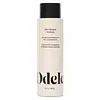What's inside
What's inside
 Key Ingredients
Key Ingredients

 Benefits
Benefits

 Concerns
Concerns

 Ingredients Side-by-side
Ingredients Side-by-side

Water
Skin ConditioningCocamidopropyl Betaine
CleansingSodium Methyl Cocoyl Taurate
CleansingSodium Lauroyl Methyl Isethionate
CleansingGlycerin
HumectantDecyl Glucoside
CleansingSodium Chloride
MaskingPanthenol
Skin ConditioningHydrolyzed Rice Protein
Skin ConditioningOryza Sativa Seed Protein
AntioxidantOryza Sativa Extract
AbsorbentAllantoin
Skin ConditioningNiacinamide
SmoothingPyridoxine Hcl
Skin ConditioningCalcium Pantothenate
Sodium Ascorbyl Phosphate
AntioxidantTocopheryl Acetate
AntioxidantPotassium Laureth-4 Carboxylate
Polyquaternium-22
C12-13 Pareth-9
EmulsifyingPEG-120 Methyl Glucose Trioleate
CleansingPEG-150 Pentaerythrityl Tetrastearate
EmulsifyingArginine
MaskingCoconut Acid
CleansingPEG-6 Caprylic/Capric Glycerides
EmulsifyingDicaprylyl Ether
EmollientTrisodium Ethylenediamine Disuccinate
Glyceryl Oleate
EmollientSodium Starch Octenylsuccinate
AbsorbentPropanediol
SolventMaltodextrin
AbsorbentPhytic Acid
Sodium Citrate
BufferingGluconolactone
Skin ConditioningSilica
AbrasiveCalcium Gluconate
HumectantSodium Gluconate
Skin ConditioningCitric Acid
BufferingSodium Benzoate
MaskingPhenoxyethanol
PreservativePotassium Sorbate
PreservativeBenzoic Acid
MaskingParfum
MaskingWater, Cocamidopropyl Betaine, Sodium Methyl Cocoyl Taurate, Sodium Lauroyl Methyl Isethionate, Glycerin, Decyl Glucoside, Sodium Chloride, Panthenol, Hydrolyzed Rice Protein, Oryza Sativa Seed Protein, Oryza Sativa Extract, Allantoin, Niacinamide, Pyridoxine Hcl, Calcium Pantothenate, Sodium Ascorbyl Phosphate, Tocopheryl Acetate, Potassium Laureth-4 Carboxylate, Polyquaternium-22, C12-13 Pareth-9, PEG-120 Methyl Glucose Trioleate, PEG-150 Pentaerythrityl Tetrastearate, Arginine, Coconut Acid, PEG-6 Caprylic/Capric Glycerides, Dicaprylyl Ether, Trisodium Ethylenediamine Disuccinate, Glyceryl Oleate, Sodium Starch Octenylsuccinate, Propanediol, Maltodextrin, Phytic Acid, Sodium Citrate, Gluconolactone, Silica, Calcium Gluconate, Sodium Gluconate, Citric Acid, Sodium Benzoate, Phenoxyethanol, Potassium Sorbate, Benzoic Acid, Parfum
Water
Skin ConditioningSodium Lauroyl Methyl Isethionate
CleansingCocamidopropyl Betaine
CleansingPropanediol
SolventAcrylates Crosspolymer-4
Emulsion StabilisingCocamidopropyl Hydroxysultaine
CleansingGlycerin
HumectantAminomethyl Propanol
BufferingGlycol Distearate
EmollientAloe Barbadensis Leaf Juice
Skin ConditioningAvena Sativa Kernel Extract
AbrasiveAmaranthus Caudatus Seed Extract
Skin ConditioningHydrolyzed Rice Protein
Skin ConditioningHydrolyzed Quinoa
Skin ConditioningCetrimonium Chloride
AntimicrobialPolyquaternium-10
Ethylhexylglycerin
Skin ConditioningPhenoxyethanol
PreservativeSodium Hydroxide
BufferingCitric Acid
BufferingWater, Sodium Lauroyl Methyl Isethionate, Cocamidopropyl Betaine, Propanediol, Acrylates Crosspolymer-4, Cocamidopropyl Hydroxysultaine, Glycerin, Aminomethyl Propanol, Glycol Distearate, Aloe Barbadensis Leaf Juice, Avena Sativa Kernel Extract, Amaranthus Caudatus Seed Extract, Hydrolyzed Rice Protein, Hydrolyzed Quinoa, Cetrimonium Chloride, Polyquaternium-10, Ethylhexylglycerin, Phenoxyethanol, Sodium Hydroxide, Citric Acid
Ingredients Explained
These ingredients are found in both products.
Ingredients higher up in an ingredient list are typically present in a larger amount.
Citric Acid is an alpha hydroxy acid (AHA) naturally found in citrus fruits like oranges, lemons, and limes.
Like other AHAs, citric acid can exfoliate skin by breaking down the bonds that hold dead skin cells together. This helps reveal smoother and brighter skin underneath.
However, this exfoliating effect only happens at high concentrations (20%) which can be hard to find in cosmetic products.
Due to this, citric acid is usually included in small amounts as a pH adjuster. This helps keep products slightly more acidic and compatible with skin's natural pH.
In skincare formulas, citric acid can:
While it can provide some skin benefits, research shows lactic acid and glycolic acid are generally more effective and less irritating exfoliants.
Most citric acid used in skincare today is made by fermenting sugars (usually from molasses). This synthetic version is identical to the natural citrus form but easier to stabilize and use in formulations.
Read more about some other popular AHA's here:
Learn more about Citric AcidCocamidopropyl Betaine is a fatty acid created by mixing similar compounds in coconut oil and dimethylaminopropylamine, a compound with two amino groups.
This ingredient is a surfactant and cleanser. It helps gather the dirt, pollutants, and other impurities in your skin to be washed away. It also helps thicken a product and make the texture more creamy.
Being created from coconut oil means Cocamidopropyl Betaine is hydrating for the skin.
While Cocamidopropyl Betaine was believed to be an allergen, a study from 2012 disproved this. It found two compounds in unpure Cocamidopropyl Betaine to be the irritants: aminoamide and 3-dimethylaminopropylamine. High-grade and pure Cocamidopropyl Betaine did not induce allergic reactions during this study.
Learn more about Cocamidopropyl BetaineGlycerin is already naturally found in your skin. It helps moisturize and protect your skin.
A study from 2016 found glycerin to be more effective as a humectant than AHAs and hyaluronic acid.
As a humectant, it helps the skin stay hydrated by pulling moisture to your skin. The low molecular weight of glycerin allows it to pull moisture into the deeper layers of your skin.
Hydrated skin improves your skin barrier; Your skin barrier helps protect against irritants and bacteria.
Glycerin has also been found to have antimicrobial and antiviral properties. Due to these properties, glycerin is often used in wound and burn treatments.
In cosmetics, glycerin is usually derived from plants such as soybean or palm. However, it can also be sourced from animals, such as tallow or animal fat.
This ingredient is organic, colorless, odorless, and non-toxic.
Glycerin is the name for this ingredient in American English. British English uses Glycerol/Glycerine.
Learn more about GlycerinHydrolyzed Rice Protein is protein extracted from rice. This ingredient is rich in antioxidants and peptides.
Studies show this ingredient may help with blocking the melanin creation process when skin is exposed to UV.
Phenoxyethanol is a preservative that has germicide, antimicrobial, and aromatic properties. Studies show that phenoxyethanol can prevent microbial growth. By itself, it has a scent that is similar to that of a rose.
It's often used in formulations along with Caprylyl Glycol to preserve the shelf life of products.
Propanediol is an all-star ingredient. It softens, hydrates, and smooths the skin.
It’s often used to:
Propanediol is not likely to cause sensitivity and considered safe to use. It is derived from corn or petroleum with a clear color and no scent.
Learn more about PropanediolSodium Lauroyl Methyl Isethionate is a cleansing ingredient. It is a surfactant, meaning it helps gather dirt, oil, and other pollutants. This helps them be rinsed away easily.
Water. It's the most common cosmetic ingredient of all. You'll usually see it at the top of ingredient lists, meaning that it makes up the largest part of the product.
So why is it so popular? Water most often acts as a solvent - this means that it helps dissolve other ingredients into the formulation.
You'll also recognize water as that liquid we all need to stay alive. If you see this, drink a glass of water. Stay hydrated!
Learn more about Water